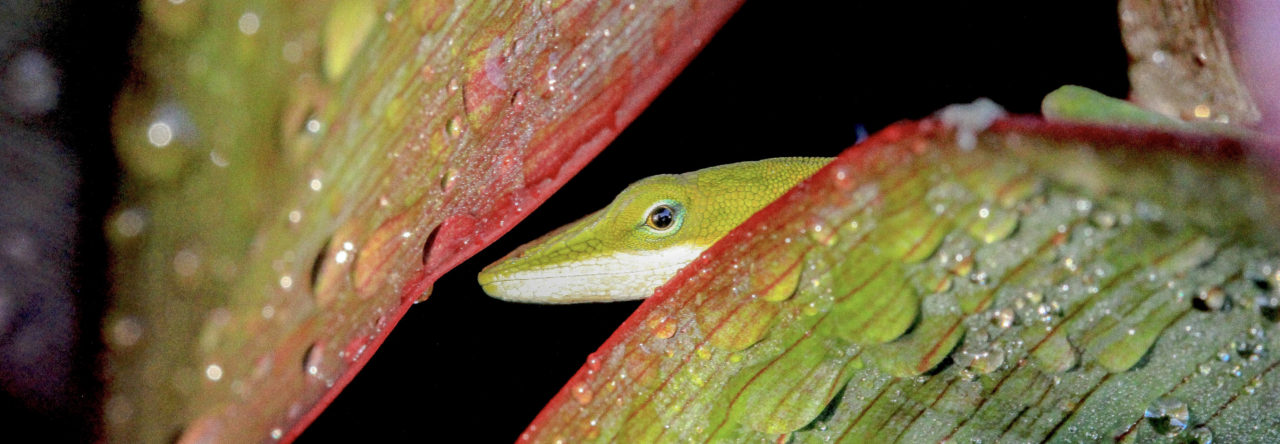
Anolis nubilus. Photo by Colin Donihue.
From the pages of Popular Science.
Efforts to save Anolis nubilus have been reported previously on Anole Annals and Colin Donihue’s website.
Population of nearly extinct lizard grows 16X in only six years

A nearly-extinct Caribbean reptile is showing signs of a comeback following years of conservation efforts. The population of the Sombrero ground lizard (Pholidoscelis corvinus) has increased from less than 100 individuals in 2018, to over 1,600 in 2024. The huge population jump is detailed in a survey released on December 18.
Sombrero ground lizards are a small reptile that primarily eats the eggs of ground-nesting birds, corn, and other plants. It is endemic to Sombrero, the northernmost island of the Lesser Antilles and roughly 34 miles off the coast of Anguilla. This tiny Caribbean island ranks in the top three of the world’s 36 biodiversity hotspots, with several species that are only found on this 94 acre island. The colorful Sombrero Island bee, a to-be-named pygmy gecko, and the Sombrero Island wind scorpion, and numerous others all call this place home. The island also supports large seabird colonies and is designated as an Important Bird Area.
“The Critically Endangered Sombrero ground lizard is an endemic species, which means it’s found only on Sombrero Island and nowhere else in the world,” Farah Mukhida, a natural resources manager and Executive Director at Anguilla National Trust tells Popular Science. “It’s a beautiful little reptile with its black-blue scales.”
A study from 1999 estimated there were only between 396 and 461 individuals left. Sombrero Island was also once on the verge of environmental collapse. Mineral mining, a population of invasive mice, deforestation, and severe hurricanes had all taken their toll.
“That it’s managed to survive decades of phosphate mining, invasive species, and now climate change with longer periods of drought, higher temperatures, and even stronger hurricanes and storm surges that sweep over the island is absolutely astounding and shows just how resilient this lizard is,” says Mukhida.

Major conservation efforts beginning in 2021 have focused on removing the invasive mice and planting more native species on the island. Experts from the Anguilla National Trust, Fauna & Flora, and Re:wild have worked to help the Sombrero ground lizard and its island habitat recover. The lizards are showing huge signs of improvement, with their population increasing roughly 16 times in six years.
“We were absolutely ecstatic when we analysed the results of our population surveys and found this enormous increase in their numbers,” says Mukhida.
The island itself has been declared pest-free and is much more green. Native plants including the sea bean, seagrape, and prickly pear are already showing healthy new growth. The conservationists are also expressing some cautious optimism for the future.

“This is a remarkable turnaround for this cheeky and charismatic lizard but while we celebrate this recovery, we recognise that there is much more to be done to secure their future and that of other Caribbean wildlife,” Jenny Daltry, Caribbean Alliance Director, Fauna & Flora and Re:wild, said in a statement. “The combined impacts of biodiversity loss and climate breakdown are being felt with greater intensity every year in the Caribbean and around the world. Indeed, we are still busy helping our partners in Jamaica and St Vincent and the Grenadines to recover from the devastation wreaked by Hurricane Beryl earlier this year.”
Efforts will continue to preserve this biodiversity hotspot in the face of a changing landscape. One of the factors helping this recovery is the island’s distance from the mainland and fairly low number of visitors. The team plans constant vigilance to make sure they can respond quickly if more invasive rodents arrive. The continued re-wilding here will also require constant upkeep for the island’s flora, including building soil reserves and sowing additional seeds.

“These restoration interventions have cascading effects: they attract insects which help pollinate plants, they attract birds that drop seeds, they provide food and shelter for lizards that also serve as seed dispersers, pollinators, and nutrient transporters,” says Mukhida. “We’re committed to Sombrero’s recovery, sharing lessons learned, and building on successes.”
- Evolution in Real Time on Lizard Island - March 23, 2025
- Spider Snags Adult Anolis osa - March 22, 2025
- An Homage to the Green Anoles of New Orleans - March 21, 2025


Leave a Reply